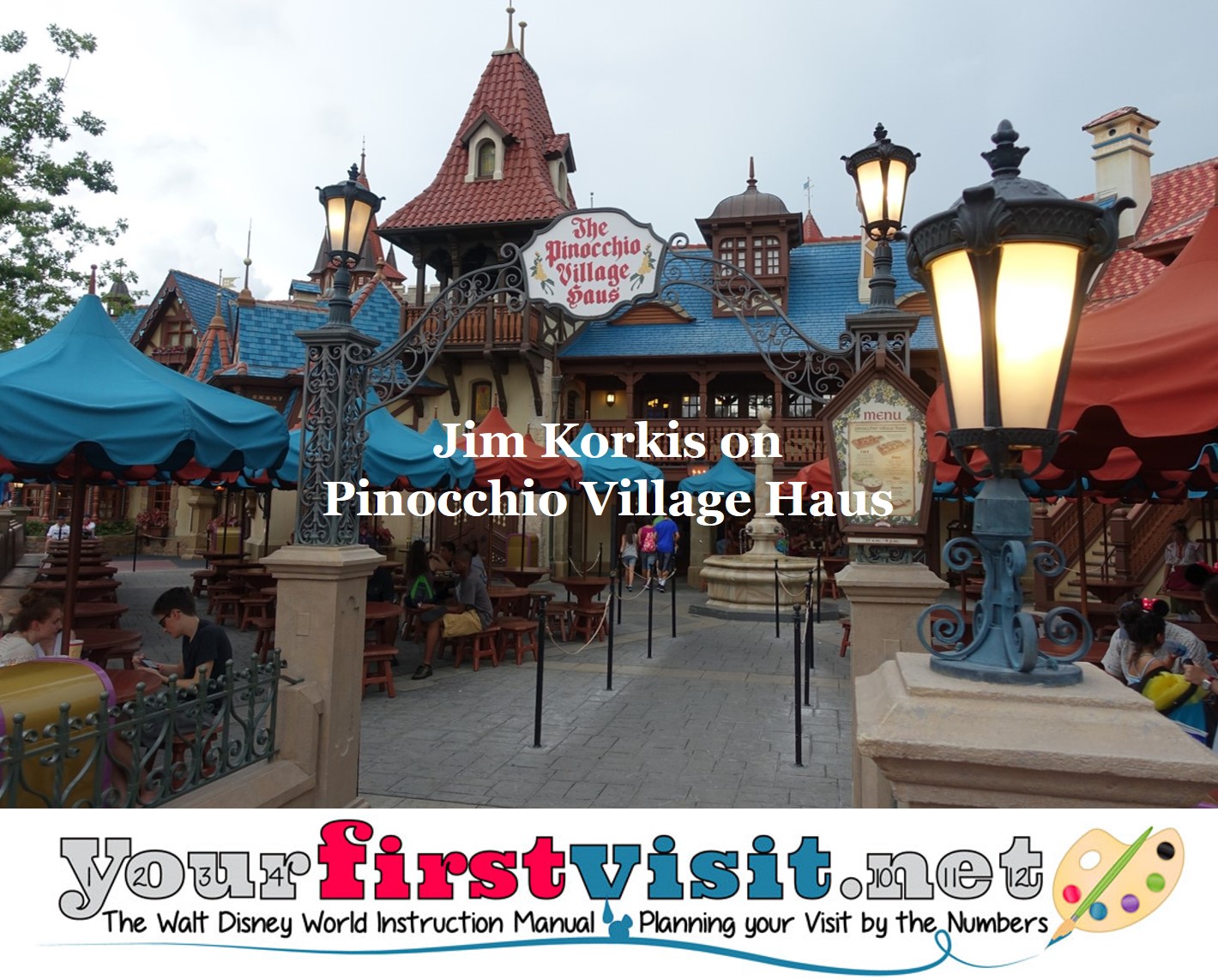A Friday Visit with Jim Korkis: Pinocchio Village Haus
By Dave Shute
Welcome back to Fridays with Jim Korkis! Jim, the dean of Disney historians and author of Jim’s Gems in The easy Guide, writes about Walt Disney World history every Friday on yourfirstvisit.net.
PINOCCHIO VILLAGE HAUS
By Jim Korkis
If the 1883 children’s story about Pinocchio, the little wooden puppet who came miraculously to life, is Italian, then why does the restaurant in Magic Kingdom’s Fantasyland resemble a medieval Bavarian building and uses the German word “haus”?
Walt Disney specifically wanted his animated feature Pinocchio (1940) to have the same artistic approach that echoed the old world storybook illustrations done by German artists that had made Snow White and the Seven Dwarfs (1937) such a success.
For the film, concept artist Gustaf Tenggren was responsible for the design of the Alpine town in the shadow of the mountains. The Germanic influences include not only the architectural detail in the streets but also the carved interior of Gepetto’s workshop. The character of Gepetto is German as are the toys, clocks and music boxes he carves. Even actor Christian Rub who voices Gepetto was German.
Tenggren’s inspiration for the buildings, signs, streets, steps and more in the final film were from the many drawings he had done of a Bavarian town called Rothenburg ob der Tauber. Gepetto’s house bares a close resemblance to the Hotel Altfrankische Weinstube in that town.
In fact, Pinocchio’s Village Haus was meant to so precisely recall the classic animated feature, that the view from above, which when the Magic Kingdom opened in October 1971 could be enjoyed on a leisurely Skyway ride that closed in November 1999, resembles the overhead opening scene in the film.
That view, as well as the one in the film, included a distinctive bell tower. Imagineer John Hench had located an old rusting, dented bell that was able to duplicate the exact ringing tone necessary.
Unfortunately, after the bell was shipped from California to Florida, overeager workmen in Central Shops cleaned off the rust and hammered out the dents and the bell no longer had its pleasing tone. An audio electronic track was substituted.
The world “village” was chosen specifically for this food and beverage location because both the exterior and the interior are designed with a village courtyard and separate “houses” clustered together since a building this large would not have served as a restaurant in medieval times. There are even different weather vanes on the roof to suggest different businesses or families living below.
The main entrance, although indoors, is designed to invoke the outdoors with a lighted ceiling suggesting the sky and the various food counters having shingled roofs on building facades with stained glass windows and flowerboxes.
The largest dining area is the Stromboli Room. Outside the building is puppeteer Stromboli’s cart that he uses to travel from town to town to perform his puppet shows and sell merchandise. Entering from that cart into the building takes a guest into the puppet theater.
The long, thin stained glass windows feature marionettes on strings while the narrow small balcony up above the seating area is meant to suggest the catwalk of a theater. A large fresco on the wall reads, “Stromboli presents Pinocchio the string-less puppet” just like a poster for the show.
Each of the other dining rooms are homages to different characters from Pinocchio: The Blue Fairy, Geppetto (with wooden cuckoo clocks), Cleo (all glassed in like a fish bowl with images of the fish swimming), Figaro, Jiminy Cricket, and Monstro (near the window overlooking the Small World oceans where he roamed).
The location even includes two porcelain tile covered authentic German bakery ovens that still work. An architectural mistake in the installation of an Exit sign has been corrected by painting the mischievous cat Figaro seemingly playfully moving it off center.
* * * * *
Thanks, Jim! Come back next Friday for even more from Jim Korkis!
In the meantime, check out his books, including Secret Stories of Walt Disney World: Things You Never You Never Knew, which reprints much material first written for this site, and The Vault of Walt: Volume 4, and his contributions to The easy Guide to Your Walt Disney World Visit, all published by Theme Park Press.
Follow yourfirstvisit.net on Facebook or Google+ or Twitter or Pinterest!!






0 comments
Comment by typing in the form below.
Leave a Comment | Ask a Question | Note a Problem